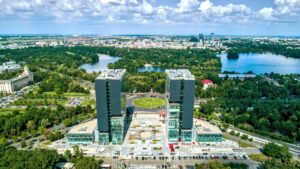
Sursa foto: www.sulyokimaging.ro
The Bucharest-Ilfov Region
Bucharest-Ilfov is one of the eight development regions of Romania, composed of the municipality of Bucharest and Ilfov County. It is located in the southern part of the country, in the central area of the Romanian Plain, with a population of over 2.2 million inhabitants and an area of 1,821 km², of which 13.1% represents the administrative territory of Romania’s Capital. The settlement network of the Bucharest-Ilfov Region consists of 9 cities and 32 communes. Among the 9 cities, only Bucharest holds the status of a municipality.
Ilfov County includes 40 territorial-administrative units, specifically 8 cities (Bragadiru, Buftea, Chitila, Măgurele, Otopeni, Pantelimon, Popești-Leordeni, and Voluntari) and 32 communes (1 Decembrie, Afumați, Balotești, Berceni, Brănești, Cernica, Chiajna, Ciolpani, Ciorogârla, Clinceni, Copăceni, Corbeanca, Cornetu, Dărăști-Ilfov, Dascălu, Dobroești, Domnești, Dragomirești-Vale, Găneasa, Glina, Grădiștea, Gruiu, Jilava, Moara Vlăsiei, Mogoșoaia, Nuci, Periș, Petrăchioaia, Snagov, Ștefăneștii de Jos, Tunari, Vidra).
Demographically and urbanistically, Bucharest is the most developed city, while economically, it is the most prosperous locality in Romania, serving as one of the main commercial and industrial centers.
The Bucharest-Ilfov Region is the most developed in Romania, with a GDP per capita (expressed in purchasing power parity) of €40,400, representing 139% of the European average (EU28), surpassing regions that include other European capitals such as Athens (92%), Madrid (125%), Berlin (118%), or Budapest (102%), according to Eurostat 2018, based on 2016 data. The economy of the Region is largely dominated by the functions of the Capital, with the active population linked to the entities operating here.
This Region, dominated by the municipality of Bucharest, is the most important national and international hub for road, rail, and air transport in the country. The Region is characterized by a high degree of accessibility, being located on the Pan-European Transport Corridor IV (Dresden/Nuremberg — Prague — Vienna — Bratislava — Győr — Budapest — Arad — Bucharest — Constanța/Craiova — Sofia — Thessaloniki/Plovdiv — Istanbul) as well as on the Pan-European Transport Corridor IX (Helsinki — Vyborg — Saint Petersburg — Pskov — Moscow — Kaliningrad — Kyiv — Liubashivka/Rozdilna (Ukraine) — Chișinău — Bucharest — Dimitrovgrad — Alexandroupolis). Essentially, the two pan-European transport corridors follow the old European trade routes: one connected Western Europe with the East (Vienna – Istanbul), while the other, on the North-South axis, known as the “Road from the Varangians to the Greeks,” linked Southern Europe with the northern areas of the old continent.
Air accessibility is ensured by Romania’s largest international airport, Henri Coandă (Otopeni), which handles regular scheduled flights, as well as Băneasa Airport, designated exclusively for private flights.
As for public passenger transportation in the region, it began in 1871 with the establishment of the “Romanian Tramway Company,” and the first horse-drawn trams started operating on the streets of the Capital. In 1894, the first electric tram line was inaugurated on the Obor–Cotroceni route, and in 1936, the “Municipal Society for the Construction and Operation of Trams in Bucharest” (founded in 1909 and known as STB) obtained exclusivity for public transport with trams and buses across the entire Capital, including 12 suburban communes. The bus fleet consisted of 392 vehicles, operating on 22 routes. In 1949, Bucharest saw its first trolleybus line, running on the Piața Victoriei–Băneasa Hippodrome route.
The municipality of Bucharest is also the most important university center in the country. Thus, in the 33 universities of the Bucharest-Ilfov Region (half of which are accredited private educational institutions), one-third of the approximately 500,000 students registered annually nationwide are enrolled.
Among the most important university centers are:
- The “Gheorghe Ionescu-Șișești” Academy of Agricultural and Forestry Sciences (ASAS)
- The Bucharest University of Economic Studies (ASE)
- The Alexandru Ioan Cuza Police Academy in Bucharest
- The National Intelligence Academy
- The Bucharest Military Technical Academy
- The National Academy of Physical Education and Sports (ANEFS)
- The National School of Political and Administrative Studies (SNSPA)
- The National School of Public Health, Management, and Training in Bucharest
- The Civil Aviation Training School
- The University of Bucharest
- The “Ion Mincu” University of Architecture and Urbanism
- The National University of Arts
- The “Carol Davila” University of Medicine and Pharmacy in Bucharest
- The University of Agronomic Sciences and Veterinary Medicine in Bucharest
- The “Ion Luca Caragiale” National University of Theatre and Film (UNATC)
- The “Ciprian Porumbescu” National University of Music in Bucharest
- The Polytechnic University of Bucharest
- The Technical University of Civil Engineering Bucharest (UTCB)
- The “Carol I” National Defense University
Pre-university education in the region includes 657 institutions in Bucharest and 256 in Ilfov County, comprising kindergartens, daycare centers, sports clubs, theoretical high schools, technological high schools, seminaries, vocational schools, primary schools, secondary schools, special schools, and more. In 2019, at the secondary level, there were 10 private educational institutions in Bucharest and four in Ilfov.
The number of vehicles operating in the Capital and Ilfov County exceeds 2.5 million. At the end of 2017, a report from the Directorate for Driver’s License and Vehicle Registration (DRPCIV) showed that Bucharest alone had approximately 1.3 million registered vehicles, in addition to those registered in Ilfov County and those transiting the region daily.
The Bucharest-Ilfov Region also represents Romania’s largest industrial agglomeration, with the highest Gross Domestic Product (GDP) in the country, standing at €5,616.7 per capita—about double the national average. Thus, the region contributes over 27% of the national GDP, according to Eurostat.
The Bucharest-Ilfov region boasts numerous tourist attractions. In Ilfov County, you can find:
- The Brâncovenesc Palace in Mogoșoaia, over 300 years old. It was built by the order of Constantin Brâncoveanu in the Brâncovenesc style, a Romanian eclectic style combining Renaissance, Oriental, and Baroque elements. The estate includes the inner courtyard, park, a lake, and the “Saint George” Church.
- Snagov Palace, the former royal palace built in the 1930s for Prince Nicolae of Romania. In 1937, Prince Nicolae was disinherited, and the palace was taken over by Ion Antonescu and later by Gheorghe Gheorghiu-Dej. In the early 1970s, on Nicolae Ceaușescu’s orders, the palace was completely redesigned based on the architectural ideas of Henriette Delavrancea, preserving only the entrance, staircase, and the hall leading upstairs.
- Snagov Monastery, famed for a legend that claims it houses the tomb of Vlad Țepeș (Vlad the Impaler). According to the story, the ruler’s body was found and hidden by the monks after he was killed in a battle with the Turks in 1476, and later buried here. However, some historians dispute the legend, suggesting Vlad Țepeș’s tomb might be in his foundation at Comana.
- Snagov Natural Reserve, which spans over 100 hectares and includes a forest of approximately 10 hectares. The reserve is home to about 2,700 species of plants and animals, of which 171 are protected and extremely rare.
- Cernica Monastery, dating back to 1608, founded by Cernica Știrbei, the marshal of Mihai Viteazu. The monastic complex includes three churches built in the early 19th century, three chapels, and a cemetery where several prominent Romanian figures are buried, such as Theodor Văcărescu (politician), Gurie Gosu (Metropolitan of Bessarabia), Nifon (Primate Metropolitan of Romania), Gala Galaction (poet and writer), Ion Țuculescu (doctor and painter), Vasile Gorduz (sculptor), Johnny Răducanu (artist), and others.
- Samurcășești Monastery, unique as the only Orthodox place of worship in Romania with three altars. It also houses relics of saints such as Saint Andrew the Apostle, Saint John Chrysostom, Saint Stephen the Archdeacon, Saint Demetrius the Myrrh-Gusher, and others. The monastery’s cemetery features Tudor Vladimirescu’s fir tree, about which legends say he visited to reflect and seek advice from Samurcaș, the founder of the place of worship.
- Căldărușani Monastery, one of the most beautiful and significant places of worship in the historical region of Muntenia. It is located in Gruiu Commune, in northern Ilfov County, 45 kilometers from Bucharest. The monastery was founded by Prince Matei Basarab, who ordered its construction in 1638 on the site of a former wooden church.
- The Ruins of Chiajna Monastery, one of the most famous monasteries in southern Romania due to its legends. It is said to be cursed, as priests never had the opportunity to serve there because the monastery was bombarded by the Turks before it was consecrated. Legends also claim that Metropolitan Cosma Popescu of Wallachia died there due to the plague, leading to its abandonment.
In Bucharest, the main tourist attractions include:
- The Palace of Parliament, built in the Brâncovenesc style with Renaissance, Baroque, and Germanic influences. This grandiose building impresses with its architectural style and over 1,000 rooms. It is the second-largest administrative building for civilian use by surface area in the world and the most expensive administrative building globally. Also known as the People’s House, it symbolizes interior opulence, featuring massive wooden furniture, impressive crystal chandeliers, immense marble columns, and carefully chosen interior design elements for each room.
- The Romanian Athenaeum, constructed almost 130 years ago as a palace of arts and sciences. It hosted its first lecture series by Alexandru Odobescu on February 14, 1888, at 8:30 PM. The Athenaeum was restored and modernized between 1994 and 2004, reopening to the public in 2005.
- The Museum of the Romanian Peasant, which holds the richest collection of traditional items in the country, including unique ceramics and various folk costumes from all Romanian regions. The building housing this unique museum was constructed in the Neo-Romanian style and is declared a historical monument.
- The National Museum of Natural History “Grigore Antipa”, showcasing impressive scientific collections with millions of specimens of vertebrates and invertebrates. Its offering includes unique rocks, minerals, and temporary exhibitions.
- The Village Museum, an open-air museum whose idea took root in the second half of the 19th century. In 1867, Alexandru Odobescu proposed displaying monuments of traditional architecture at the Universal Exposition in Paris. Later, scholar Alexandru Țzigara Samurcaș envisioned bringing “authentic and complete households from significant regions inhabited by Romanians” to the Ethnographic Museum of National Art, Decorative Art, and Industrial Art in Bucharest, founded by him in 1906. This project materialized in 1909 with the display of a traditional house from Gorj County. The Village Museum resulted from over a decade of intense research and museographic experiments led by Professor Dimitrie Gusti. It officially opened on May 10, 1936, in the presence of King Carol II, and to the public a week later, on May 17, 1936.
- The Historic Center of Bucharest, one of the most charming areas of the city, filled with history and tradition. It is renowned for its vibrant atmosphere, thanks to numerous terraces, restaurants, and clubs, making it an attraction for both tourists and locals. The area, also known as Old Town, originated around 1600 when the first inns and shops appeared near the Royal Court. Its development continued due to the concentration of political and economic power in Bucharest, which became the sole capital of Wallachia after 1660. Notable landmarks include Hanul cu Tei, the famous Manuc’s Inn, with its impressive architecture, wooden pavilions, arcades, and wrought iron ornaments, a symbol of Romania’s history. The Old Court Church, the city’s oldest church, was founded by Mircea Ciobanul during his first reign (1545-1554). Serving as the coronation site for Wallachian rulers for two centuries, the church is a pilgrimage site due to the Miraculous Icon, the only artifact that survived the great fire of 1847.
- The Coral Temple, Romania’s largest Jewish place of worship, built in the mid-1800s as a replica of the Tempelgasse Synagogue in Vienna, destroyed by the Nazis during World War II.
Other tourist attractions in Bucharest include Cișmigiu Park (one of Europe’s oldest and most beautiful parks), Herăstrău Park (a popular leisure area), Suțu Palace, Cantacuzino Palace, The Arch of Triumph, CEC Palace, Casa Capșa, Bellu Cemetery, and Cotroceni Palace.



